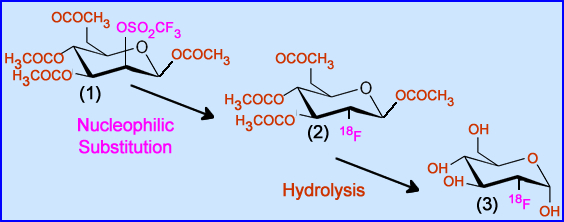Synthesis of 18F
- USP <823> is the regulatory aspect in the radiopharmaceutical compounding of PET tracers
- Issue - testing for endotoxins and pathogens on radiopharmaceuticals that have very short lived agents
- In the future (~2011) all cyclotrons will have to have a manufacturer license
- Molecular imaging occurs
- Basic agents used in PET are elements that occur at the cellular level: C, N, O, F
- Relates to the concept of molecular imaging
- Nucleophilic Substitution
- Replaces a group or element within molecule or molecular chain
- Radiolabeling of FDG is done in this manner

- Mannose Triflate (1) is the initial component needed to develop FDG
- Trimethly sulfate (OSO2CF3) is the leaving group within the carbon ring that is (2) replaced by 18F via nucleophilic substitution
- Acetal groups (H3COCO and OCOCH3) are removed and replaced with OH - hydrolysis with the end result FDG (3)
- Can be done by adding an acid or a base
- Hyrdolysis by adding HCl or NaOH
- Note the above reactions are color coded
- Once FDG has be produced
- Acetone and acetanitriles helps clean/remove contaminates
- Usually occurs in collums
- Micropore filter is used to assist in sterilezation and filtering of the final product 18FDG
- Everything is now done on a cassette that contains all the necessary compounds to label 18F
- Very efficient
- Has all the components needed to tag
- Hook up the lap top
- The process then takes about 25 minutes
- Other types of nucleophilic substitution can make different
- 18Fluorothymidine (FLT) gives a 6 - 12% yeild
- Cleanup becomes more difficult: requires pressure device, seperations, and then capturing the labeled compound
- Cost $50k to $250k
- Test required on FDG prior to injection into a patient
- Visual - is it clear and colorless and lacks particles?
- Filter member integrity - air pressure test to make sure that the filter isn't broken
- Radiochemical purity - <4% free
- Radionuclidic purity - Where are the peaks 511 and 1024 keV
- Radionuclidic identity - measure decay to make sure that T1/2 is 109 minutes
- pH - must be between5.5 to 7.5
- Pryrogens/endotoxins - LAL
- Chemical purity - other purities are missing with gas and thin layer chomotography (Kryptofix 222)
- Different products appear at different times on the graph
- Radiolysis
- HPLC - High Pressure Liquid Chromatography
- Sterility - Soy broth to see what cooks (2 weeks)
- 2-chloro-2-Deoxy-Dglucose - you get this if in hydrolysis you add HCl instead of NaOH
- Must be made in a class 100 room surrounded by a class 1000 room - sterile environment
Return to the Table of Content
11/20/2009
